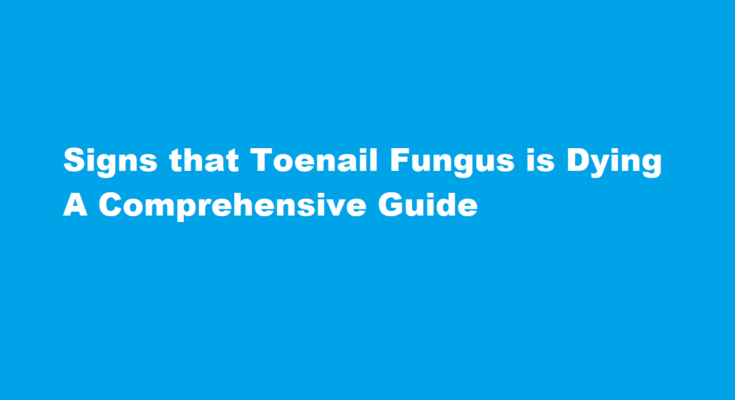Introduction
Toenail fungus, medically known as onychomycosis, is a common and stubborn condition that affects millions of people worldwide. Treating toenail fungus can be a lengthy and frustrating process, often requiring patience and persistence. However, the journey to recovery can be uplifting when you start noticing signs that the toenail fungus is dying. In this article, we will explore the telltale signs that your treatment is working and that the fungus is on its way out.
Improved Nail Appearance
One of the most obvious signs that toenail fungus is dying is an improvement in the appearance of the affected nail. Initially, an infected toenail may appear discolored, thickened, and crumbly. As the fungus begins to die off, you may notice that the nail becomes clearer and less discolored. It may even start to regain a more natural, healthy color. While this change may be gradual, it is a positive indication that your treatment is working.
Reduced Pain and Discomfort
Toenail fungus can cause pain and discomfort, especially when the infection is severe. As the fungus dies and the nail starts to heal, you may experience a reduction in pain and discomfort. This can be a significant relief, as it indicates that the infection is receding, allowing the nail and surrounding tissue to heal.
Decreased Odor
Fungal infections often come with an unpleasant odor. If you’ve been battling toenail fungus, you’re probably familiar with this foul smell. As the fungus dies, the odor associated with the infection should diminish. This is a clear sign that your treatment is working to eliminate the source of the odor – the fungus itself.
Smoother Nail Texture
Another sign that toenail fungus is dying is an improvement in the texture of the affected nail. Fungal infections can make the nail surface rough and uneven. As the fungus is treated and the nail begins to heal, you may notice that the texture becomes smoother and more like a healthy nail. This is a positive change that indicates the fungus is losing its grip on your nail.
Gradual Nail Growth
Healthy nails grow gradually, and the same principle applies to nails affected by fungus. While toenail growth is slow, you should see some progress over time. As the fungus dies and the nail regains its health, you’ll notice the growth of new, unaffected nail tissue at the base. This growth is a clear indication that the infection is receding and that your treatment is effective.
Reduced Itchiness
Itchiness is a common symptom of toenail fungus, and it can be quite bothersome. As the infection begins to subside, you may experience a decrease in itchiness and irritation. This is a positive sign that the fungus is no longer thriving and causing discomfort.
Fewer Spots or Lines
Toenail fungus can sometimes manifest as spots or lines on the nail. These spots are often a result of the fungal infection spreading beneath the nail. As the fungus dies off, you may notice a reduction in the number and visibility of these spots or lines. This is a promising sign that your treatment is addressing the infection.
Consistent Treatment Progress
Monitoring the progress of your toenail fungus treatment is crucial. Consistency in your treatment regimen is key to ensuring that the fungus continues to die off and does not return. If you see a consistent improvement in the appearance and health of your toenail over several weeks or months, it’s a strong indicator that the fungus is on its way out.
FREQUENTLY ASKED QUESTIONS
What color is toenail fungus when it dies?
However, it’s also one of the first things to change when your treatment starts working. When medication starts to take effect, your toenails will begin to revert back to their normal clear color. This is a good visual indicator that your toenail fungus is dying and on its way out.
What kills toe fungus the fastest?
If you want to get rid of a toenail fungus quickly, the best thing to do is to see a doctor for prescription medication such as fluconazole (Diflucan). Natural remedies may be able to relieve your symptoms, but there isn’t certainty that they will work, and even if they do, it will likely take longer.
Conclusion
Dealing with toenail fungus can be frustrating and challenging, but recognizing the signs that it is dying can be incredibly rewarding. Keep in mind that toenail fungus treatments can take time, and progress may be gradual. However, as you observe improvements in nail appearance, reduced pain and discomfort, decreased odor, smoother texture, gradual nail growth, reduced itchiness, fewer spots or lines, and consistent treatment progress, you can be more confident that your efforts are paying off. It’s essential to consult with a healthcare professional for an accurate diagnosis and treatment plan, as some cases of toenail fungus may require prescription medication or other interventions. Remember that patience and persistence are key when combating toenail fungus, and these signs of improvement can serve as encouragement on your journey to healthier, fungus-free nails.
Read Also : Crafting The Perfect Minecraft Glass A Step-by-Step Guide



